Giselle Ballet: the mythical image that represents this ballet is the long white tutu. Ballet historian Cyril Beaumont said that the role of Giselle meant to a dancer what the role of Hamlet meant to an actor. This is because the changing and complex emotions of the characters are a fundamental aspect of the plot.
Giselle is the perfect model of French romantic ballet. And it was also a resounding success from the moment of its premiere. Sounds interesting right? Well, keep reading so we can explain everything about this fabulous ballet to you.
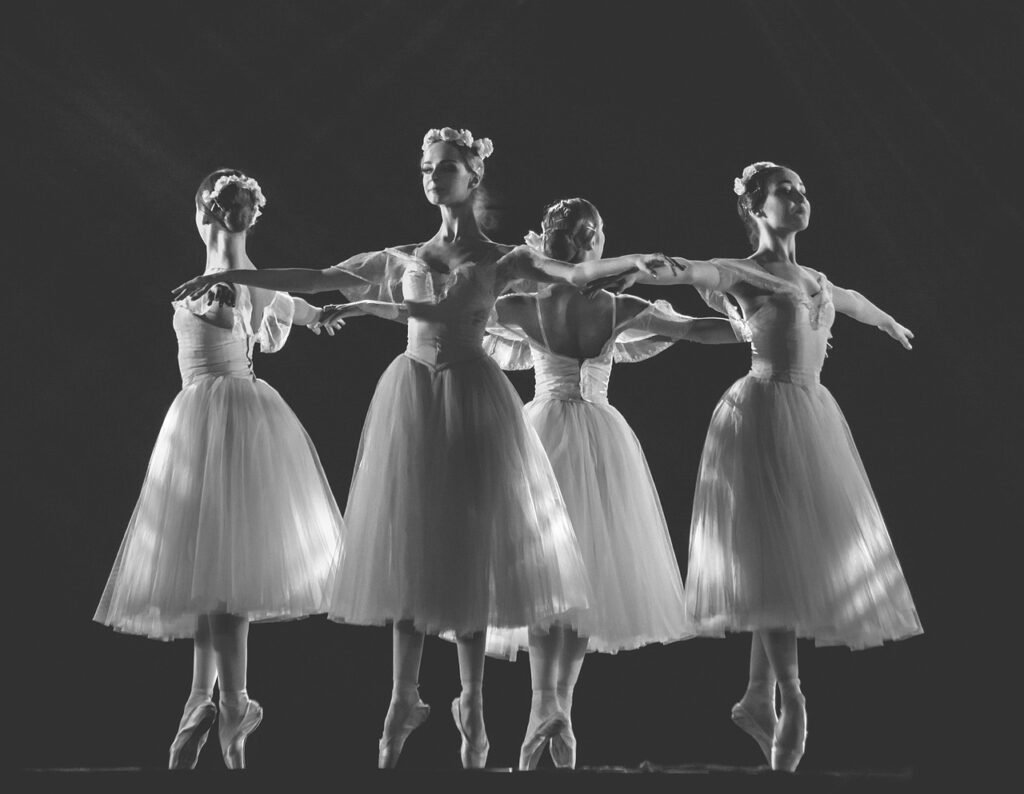
Table of Contents
Key Facts about Giselle Ballet
- Premiere date: June 28, 1841. Théâtre de l’Academie Royale de Musique (now Opéra national de Paris).
- Composer: Adolfo Adam.
- Original choreography: Jules Perrot and Jean Coralli.
- Libretto: Jules-Henri Vernoy de Saint-Georges and Théophile Gautier
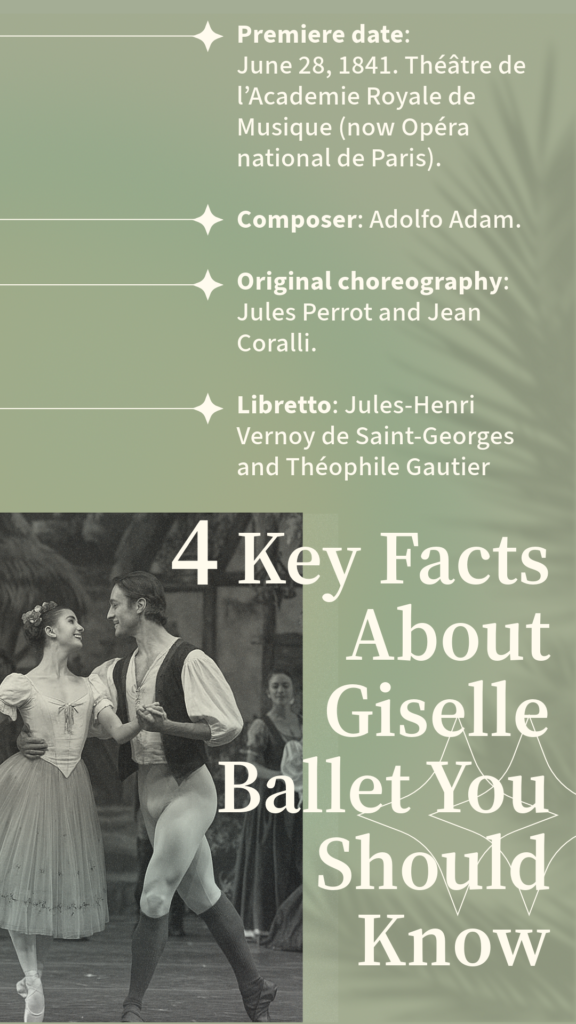
The Literary Inspirations Behind Giselle
Jules-Henri Vernoy de Saint-Georges and Théophile Gautier were inspired by a prose text from the work De L’Allemagne that the German author Heinrich Heine had written in 1835 and from a poem called Fantômes in Les Orientales by Victor Hugo.
Théophile Gautier was a famous romantic critic and poet. Reading Heine’s works, he found an appropriate motif for a ballet plot: a misty region, moonlight and female spirits called Willis who dance to exhaustion. But Gautier had no experience writing scripts. He then sought the collaboration of the skilled librettist Vernoy de Saint Georges.
It is the romantic ballet par excellence since it shows the two contrary environments: the village and human environment, and the supernatural environment. The protagonist, Giselle, is a young peasant girl who falls in love with a young man, Albrecht, who is actually a nobleman who hides her identity by falling in love with her. Giselle’s fragile health threatens her inexhaustible desire to dance.
When her deception is discovered, Giselle ends up falling dead from her pain, turning into a Willi. The next act focuses on a ghostly world where the Willis welcome Giselle. According to a Slavic legend, the Willis are the spirits of abandoned brides who attract approaching men and force them to dance until they die.
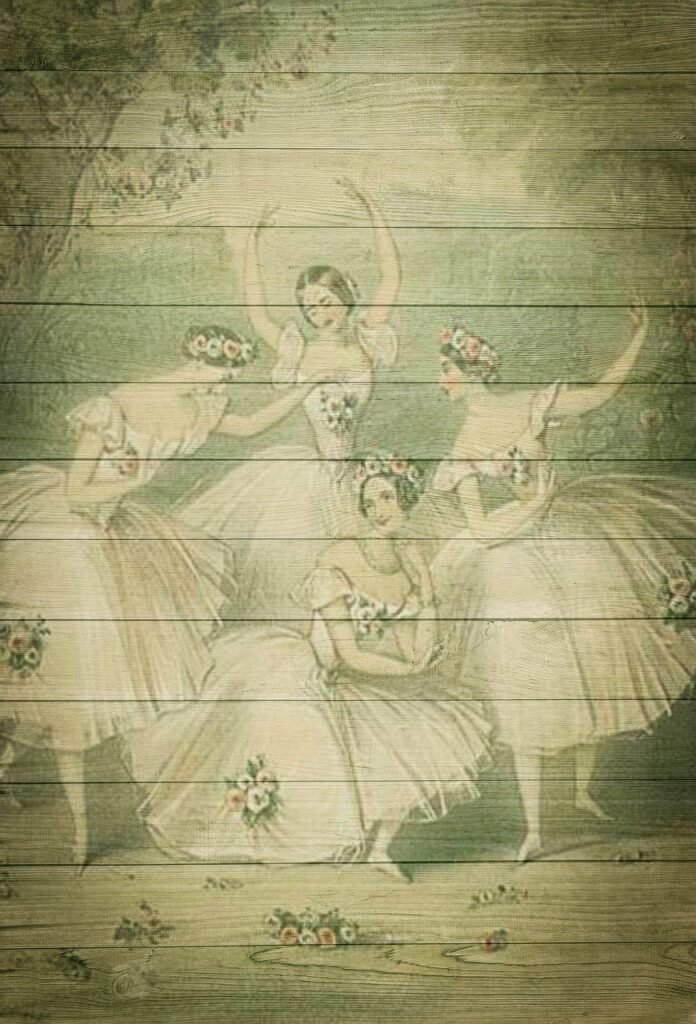
What is the Story of Giselle Ballet?
This is a ballet in two acts with two different atmospheres and colours. The first act is cheerful and colourful, showing the idealized life of a rural village. The second act is ethereal, located in a supernatural world where the Willis live, with the white colour of the long tutus dominating the scene.

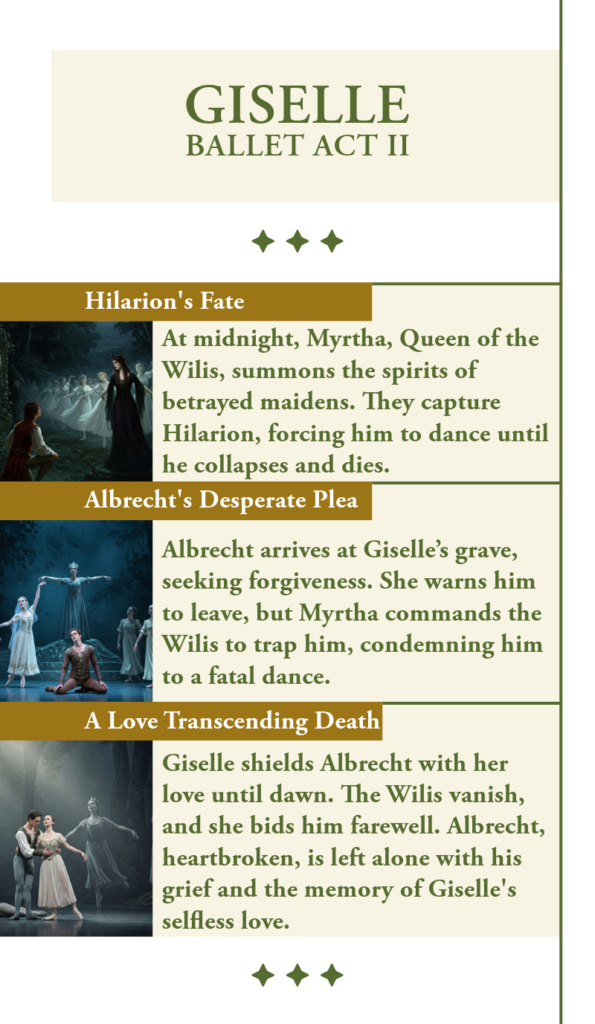
Act I
The story takes place in a small, quiet village in the Rhineland during medieval times. Giselle, a young peasant girl, expresses her happiness. She is in love and trusts that she will be reciprocated. The forester Hilarion, in love with Giselle, tries in vain to convince her that Albrecht, her lover, is not a peasant but a nobleman in disguise and that he is deceiving her.
Shortly after, Duke Albrecht arrives disguised as a peasant. Giselle dances with him to a musical theme or leitmotif that appears in other scenes under Hilarion’s suspicious gaze. He interrupts her, and a lovers’ quarrel ensues. Finally, Hilarion promises revenge.
The villagers return after work and dance a waltz to celebrate the end of the harvest. Giselle’s mother, Berthe, interrupts and relates the old superstition of what happens to maidens who die unmarried and are condemned to wander the woods like Willis. These are vengeful ghosts that attack men who cross their path, forcing them to dance an endless dance, until they collapse and die of exhaustion.
A hunting horn announces the approach of the hunters. At the head of them is Princess Bathilde, Albrecht’s fiancée, and her father, the Prince of Courland. He accepts the hospitality of the villagers who organize a party in her honor. The princess and Giselle talk to each other, and each one comments that she is engaged. So, Bathilde gives her a beautiful necklace as her dowry. Meanwhile, Hilarion, blinded by jealousy, has located Albrecht’s sword and shows it to everyone present, unmasking the latter’s deception.
Giselle is stunned to see that Bathilde and Albrecht are engaged. Then, she begins a sad dance, in which we hear the initial leitmotif but now melancholic and syncopated by pain. Finally, Giselle ends up dancing with abandon until her heart fails, and she dies in Albrecht’s arms (in some versions she commits suicide with the duke’s sword).
Act II
Hilarion goes to the forest to visit the grave of his beloved. The clock strikes midnight. Then Myrthe, the Willis Queen appears with the ghosts of the dead maidens whom Giselle has joined for the first time. The Willis capture Hilarion and force him to dance until exhaustion. Hilarion then becomes the first victim.
Shortly after, Albrecht arrives, searching for Giselle’s grave to beg her forgiveness. Giselle becomes visibly moved by her regret. She tries to warn him to leave, but it’s too late. The relentless Myrtha orders the Willis to catch him and take her life by making him dance.
But Giselle, with her love, decides to protect Albrecht, holding him until dawn. With dawn, the Willis disappear, and Giselle must say goodbye to her lover forever. Albrecht tries to hold her back. But Giselle must follow her destiny wrapped in the curse that her deception and betrayal caused. Albrecht is left alone with his pain.
Who composed the music for Giselle Ballet?
The music was composed by Adolphe Adam (1803-1856), a musician born in Paris on July 24, 1803. He was Louis Adam’s son, a renowned Alsatian musician established in Paris and who was a professor at the Conservatory.
Adolphe also trained at the Paris Conservatory with François-Adrien Boïeldieu. He helped orchestrate the overture to his opera La Dame Blanche in 1825. During a short stay in Switzerland, he contacted the librettist Eugène Scribe, an expert in the Parisian operatic media. Thanks to him, he was able to premiere La batelière de Brienz in 1827, performed at the Théâtre du Gymnase with a libretto by Scribe himself.
In 1829, he made himself known with his first one-act comic opera, Pierre et Catherine. Because of his success, he turned towards operatic music, although he also became interested in ballet. At that time, ballet had achieved great popularity in Paris.
In 1834, he achieved his first great success with La Chalet. This is considered the first authentic French-style operetta. Then, this was followed in 1836 by Le postillon de Lonjumeau, a comic opera whose aria Mes amis, requires great vocal strength and skill from the tenor. He continued working on new comic operas, among them Le rai d’Yvetot (1842), Cagliostro (1844), Le toréador (1849), Giralda (1850), and mainly Si j’étais roi (1852). He entered the Institute of France in 1844 and the Paris Conservatory in 1849.
At the same time, he composed for ballet and it is here where you can observe the transition he made towards romanticism, bringing him great successes: Faust (London, 1833); La Fille du Danube (Paris, 1836, for the dancer María Taglioni); Les Mohicans (1837), Die Hamadryaden (Berlin, 1840). However, it was Giselle (1841) that catapulted him to fame. After this success, he composed other ballets, including La jolie fille de Gand (1842), Le diable à quatre (1845) and Le Corsaire (1856).
Maybe Giselle’s music isn’t the best. But it certainly has beautiful melodies. And she has an indispensable quality: she is very suitable for dancing. Another valuable aspect of this score is the use of the leitmotif, with which Adam linked a certain melodic phrase to a character or situation. For example, each Hilarion entry is associated with a quote from Beethoven’s Fifth Symphony.
Finally, Adam died in Paris on May 3, 1856, leaving behind a vast musical production: some 40 operas, 14 ballets, but also church music, piano pieces and songs, including the Christmas song Cantique de Noel ( or Holy Night).
Some versions of Giselle
Although Giselle is the romantic ballet par excellence, some creations have changed the script. They adapted it to other periods or situations or contemporary dance styles.
Frederic Franklin’s “Creole Giselle” for the Dance Theater of Harlem Ballet premiered in 1984 at the London Coliseum in London. This work places us in 1840 in Louisiana and brings us closer to the Afro-Creole problem. According to the custom of that area, a marriage was not possible between the daughter of a freed black man and the son of the family that had freed him.
“Giselle” by Mats Ek, Ballet Cullberg (Sweden) is a contemporary dance work, that premiered in 1982. Giselle, deceived by her lover, loses her mind and ends up in an asylum. The fabrics and long tutus of the Willis are replaced by the nurses’ gowns.
Akram Khan’s “Giselle” is a contemporary dance that premiered in 2016 at the English National Ballet. It recreates social inequality and the action takes place in a fabric factory. In 2018, Khan won the National Dance Award for Best Classical Choreography for this creation and Alina Cojocaru won for Best Female Performer for this Giselle.
Giselle’s dancers
Gautier chose the young Italian dancer Carlotta Grisi to dance Giselle for the first time. From that moment on, this dancer achieved great success at the Paris Opera. At that time, this theatre was the golden goal of dancers, teachers and choreographers from all over Europe. Carlotta had the appropriate virtues for this role: astonishing virtuosity, lightness, sensitivity and great dramatic abilities. This is what the chronicles of the time record.
Jules Perrot, one of the most brilliant dancers of the 19th century, was Carlotta’s teacher, partner and lover. Perrot was also a brilliant and prolific choreographer. He was also responsible for much of Giselle’s dances. But for some reason, his name did not appear in the program or on the posters of the Parisian debut. As the sole person responsible for the choreography, the name of Jean Coralli, the official “maitre de ballet” of the Opera, appeared. Coralli was later attributed to most of the group scenes in the first act.
The list of Giselle interpreters who followed Carlotta Grisi is immense. The greatest dancers of the 19th, 20th and 21st centuries played the role with their nuances. And of course, each viewer will have their preferences as to who she was or who is the best Giselle. However, on some of them, there is absolute coincidence. For example, about the great prima ballerina Carla Fracci.
What is the moral of Giselle’s ballet?
At its core, Giselle teaches us the power of forgiveness, redemption, and the consequences of deceit. Through Giselle’s love and forgiveness, the ballet underscores the transformative nature of genuine remorse and the capacity for redemption. It is a reminder that love is strong enough to conquer even the darkest of betrayals.
Is Giselle a Russian ballet?
Most people often associate Giselle with the Russian ballet tradition because of its popularity in Russian repertoire. However, it was choreographed by Jean Coralli and Jules Perrot, with music composed by Adolphe Adam. The ballet premiered at the Paris Opera in 1841 and quickly gained international acclaim, becoming a staple in the repertoire of ballet companies worldwide.
Is Giselle a good ballet?
Giselle is one of the greatest ballets of all time, cherished for its timeless story, exquisite choreography, and emotional depth. Its popularity speaks to its universal appeal and ability to captivate audiences with its poignant narrative and breathtaking dance.
Is Giselle based on a real person?
Giselle is not based on a specific historical figure. However, the character of Giselle embodies the archetypal tragic heroine found in many romantic tales. This ballet draws inspiration from various folk legends and literary sources. But the appeal lies in its universal themes of love, betrayal, and redemption, which resonate with audiences across cultures and generations.

Is Giselle a difficult ballet?
Most experts consider Giselle a challenging ballet to perform, both technically and emotionally. Dancers must have exceptional skill and artistry to convey the depth of emotion required to bring the characters to life, particularly in the demanding roles of Giselle and Albrecht. Also, the ballet’s choreography has intricate footwork, delicate balances, and demanding partnering. This presents significant technical challenges for dancers. However, the rewards of mastering Giselle’s complexities are immense. So, it offers dancers the opportunity to delve into the depths of human emotion and showcase their artistry on stage.
Buy your tickets for Giselle Ballet 2026
Royal Opera House
14 February–20 March 2026
General booking opens on 15 October 2025
More InfoEnglish National Ballet
Thu 15 – Sun 18 Jan 2026
London Coliseum
Book


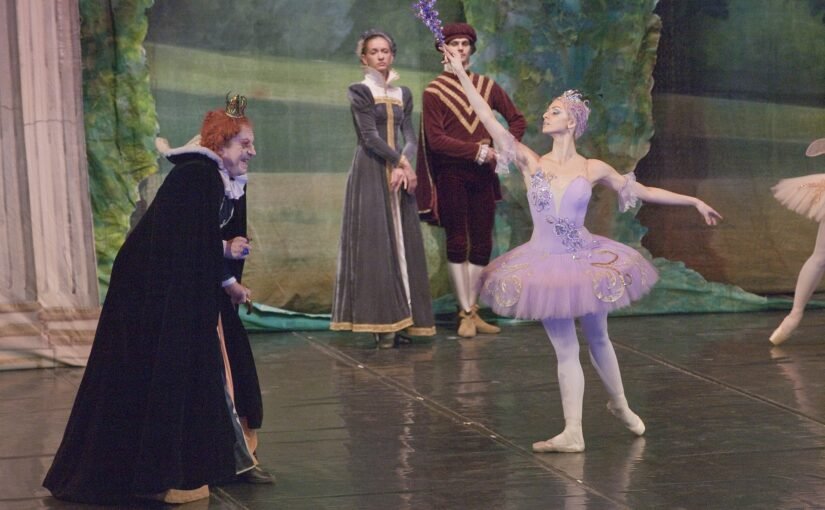

Leave a Reply